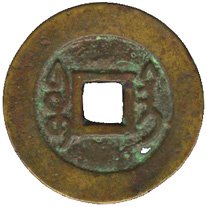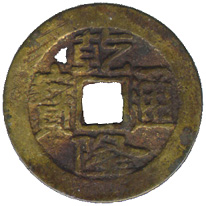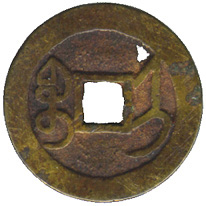| �b�����տ����A�ڬ۫H�M�N�������q�_�O�̱`�����C�Ϊ̧A�����P�N�ڪ��ݪk�C�M���v�����Ϊv����Z���Q�~�A�L�Ʀܥi�H�A���h�X�~�ӫҡC�����F���W�V�䯪���G�d���ӫҡ]�b�줻�Q�@�~�^�A�L�b���@�C�E���~�A�Ǧ��ӤӤl�A�Y�M���v�ży�ӫҡC�����Q�L���ӤW�ӫҡC���ܦ��@�C�E�E�~�A�Y�ży�|�~�A���v�~���}�H�@�A�ɦ~�K�Q�K���C�M���v�����ˬF�C�Ӱ����q�_�Y�Ϧb�����h�@��A���M�~��ű�C�S�O�b�sæ�M���õ����������٥��A�Q�H��������A�@�q�ܪ����ɶ��~��ű�����q�_�C�Ѧ��i�H�Q�������q�_��ű�B�@�w�Q����H�C |
| Ch'ien Lung T'ung Pao is the most common standard cash in the history of the Chinese coinage. I don't know whether you agree or not. Ch'ien Lung Emperor (Emperor Kao Tsung) had ruled China for 60 years. Plenty of the copper cash were cast during the period of the Ch'ien Lung reign. Actually he could have ruled longer, but he was the grandson of the K'ang Hsi Emperor, he could no exceed his grandfather who had reigned China for 61 years. Ch'ien Lung, the oldest emperor of China, was passed away in 1799 at the age of eighty eight, but Ch'ien Lung T'ung Pao went on to cast in Sinkiang province in order to show off Ch'ien Lung Emperor's success in Sinkiang. |
| ���ڮ��_�@�T�����q�_���ɭԡA�ڤ��ѱo�p�Q�_�@�Ǧ��������ӫҪ���ơC�������Q�K�~�A�Y�@�C�E�T�~����A�^�껺�ϰ�������h���ӵة^���i�^�C��^�~�]�A�Ѥ�a�z�����B�x���B�־��B�����M���������C�K��A�^�ϤJ�ѡA������ծѦ}���A�v�����C���^�ϽЬ��H�~����z�T���A�S�Цܹ�i�B�Ѭz���B�����A�����Ҥ��a�C �ӤH�H���A���ɤ������b�d�����@�����A���x�ƩM�g�٪��O�q���M�D�`�j�j�C�����ӱo�N���A�Q���j�M�Ѵ¤W�ꪺ�g�D�C�۫H�������ɻ{���G�ڤѴ¤W��A�L�Ҥ����C�i�H���������t�A���ת����A��a����B��v�ФơB�˼˭ѥ��C�ڥ��S����A�o���Z�f�i�ӨϬݦb���̡C�~�M���x�������H�ӧڤj�M�Ӵ����U�z�T���C²���O�@�j���ܡC�ڤ��m�O���A�o�차��ݮ����ʮ�A���J�Ѥ��ɤ��֦�T���E�n��§�C�۫H�����߸̤@�w�ܸҲ��C�������`�⦳�j��g�D�����q�C�絹�L�ծѤ��A�v��§���C�ΦܤE��ɡA�S�R�x���j�ڪQ�a�]�@�C���|�V�@�K�T���^�@�e�^�Ϧڦܮ����A�A�Ѥ��e�����u�s�F�g�D���^��C �G�Q�T�~��A�^��H��}���ꥫ���o���ΦרèS���ѰO�A�ܹży�G�Q�@�~�A�Y�@�K�@���~�C��A�^��A���t�@��ϸ`�����h�w��h�Ӵ¡A�ży�ӫҥH�䤣����T���E�n§���A���@���L�A�S�P�ѭ^�ӡA�O��H��]�����A���ϨӵءC�^�ꪺ�p�N��L�ש��Q�C�o�ӵ��G�Ϊ̤]�O��᪺�~���Ԫ����p�]�ƩO�H �]�ڦ����m�O���A����s�ϸ`�w�g�����d�t���A���T���E�n�j§�C���ży�����ֱ����L�C�ڰ����g�o�����ɡA���l�⩤���g�T�ͧP�H���A�g�L�Q�h�~���V�O�A�ױo�v���@�A���l�⩤������[�J�F�@�ɶT�����ѡA��{�F����b���y�g�ٶT�������a��C�L�צp��A�o�O�@��ȱo�y�P���ơC���O���v���������A��ʦ~�襤�ꪺ�L���i��A���إ��کҸg�������ĩM�ɮ�A�O�H���L�D�N�C�^ |
When I take up a piece of Ch'ien Leung Tung Pao cash coin, it is easy for me to remember that Ch'ien Lung Emperor refused to meet the British embassy led by Lord Macartney in 1793, as Macartney refused to perform the Kotow  [(Knock the head against the ground). In ancient China, it was very common for Chinese to perform the Kotow. When they were received by the emperor. Chinese did it in order to offer respect to the emperor. But, it was considered humiliating by westerners.]. In 1816, Chia Ch'ing Emperor, the 15th son of the Emperor Kao Tsung, refused to receive Lord Amherst, the second British embassador again, though he agreed to perform the Kotow. [ According to the Chinese references, this second British embassy refused to perform the Kotow again.] [(Knock the head against the ground). In ancient China, it was very common for Chinese to perform the Kotow. When they were received by the emperor. Chinese did it in order to offer respect to the emperor. But, it was considered humiliating by westerners.]. In 1816, Chia Ch'ing Emperor, the 15th son of the Emperor Kao Tsung, refused to receive Lord Amherst, the second British embassador again, though he agreed to perform the Kotow. [ According to the Chinese references, this second British embassy refused to perform the Kotow again.]Ch'ien Lung Emperor was the fourth son of Yung Zheng Emperor who died suddenly after had reigned China for 13 years before he had reached the age of 60. [The emperors of China considered China as the Central Kingdom and a great economic and cultural center, they refused to accept foreign countries as China's equals. In the eyes of the emperors, they were just tributary states. Qing government ignored the economic changes outside China. However, the British thought that free trade was beneficial to both parties. The British government had sent their diplomatic mission but failed in the end. This may be a small factor which caused the immoral Opium War.] |
|
�����q�_�q�`�N�ӫҪ��W���H�~��ű�b�����A�ӱN�Uű�����W�H����ű��I���C�b�o�������A�ڱN�@�_���Ш�T�����q�_�C�L�W�����A�C�T�ɿ������@�Ӥp�աC���q���u�ͥ����|���w�o��T�ɿ��C�]���~�ۤ��ΡC���o��Ӥp�չ�ڨӻ��o�Q�����n�C�o��T�ɿ����O���|���A�b�ڤ��e�A�۫H���ܦh�u�ͬݹL�o��T�ɿ��C���O�]�����p�աA�L�̳����n�C�̫�ک��B�a�o�J�o��T���C�ѹ껡�����q�_�@��ӻ��u���@�I�]���_���C��ı�o�ۤv���t���L�C�ڥu�H�C�T����G��b�W���ʱo�o��T�����q�_�C �ƹ�W�A�b����ܦh��G��f���a�u���A���|���¿����X��C�Ҧp�`���B���n���M�W�������o��@�a�A�ܦh�p�c�b���餤�\�R�C���M�]�i�C���ʱo�u���������A���M�B��Q�����n�C�̪�@����~���e���u�ͱоɧڡA�Y�Ʊ��״I�ۤv���ìu���ѡA�������@�ǽ��u���ìu���y�θ�ơA���ũ�L�C�Y�ϻ����ܶQ�A�]���ɶq�\Ū�C�䦸�N�O�g�`�бЧO�H�A�Y�ϧO�Hı�o�A�����D�O�M�����A�ΥO�Hı�o�A�O�L�����A�b�Ҥ��p�C��ı�o�o���I���ܦ��D�z�C |
|
Ch'ien Lung T'ung Pao were inscribed normally with the name of the reign period of issue on the front and the mint name on the back in Manchu scripts only. Recently, I have learned much from an advanced numismatist on the Internet. He suggested that "Do not hesitate to buy the specialized references, though they may be expensive to us and always ask questions concerning our collecting field. Sometimes the questions may be stupid or dull." Good Suggestions! I completely agree with him. |
| �b����A���M�ɾ\�ϮѫD�`��K�C���O�b���߹Ϯ��]�ءA����ű�������y�ܤ֡C�ڰO�o�A���@���A�ڱq���q��F�йϮ��]�A���F�d�\�@���@�E�G�E�~�X������������j�������y�A�ڷQ�d�M���@�q�����d���q�_���O���C�ڪ�F�|�Ӧh�p�ɪ��ਮ�ҹy�A���u��b�Ϯ��]���d�T�Q�����A���Fܹ�N����A�ڴN���W���}���^���q�h�C����ı�o�o�O�ȱo���A�]���ڱo��ڭn����ơC�o���ѥu�b�F�Ф��߹Ϯ��]�æ��A������~�ɡC�ڥu�n�N�b���ا۸�ơC���B�a�A�ڲ{�b�x�g�b�ʱo�@�U�F�C |
| It is very easy to borrow books from the public libraries in Hong Kong, though there are not many numismatic books in there. I remember, once I have spent more than four hours to go to the Shatin Public Library from outside island in order to make sure what Mr. F. Schjoth thought about the K'ang Hsi coins in 1929. Because the only copy of "Chinese Currency" for public is kept by the Shatin Library in Hong Kong. [I needed to spend 4.5 hours for travelling between my home and the library, but I could stay in the library for half an hour only.] It is pity, but it is worth too, as much I need to learn. Luckily, I get a copy of the book now. |
 "Shu-Heng" [cash coin unearthed long time ago] or
"Shu-Heng" [cash coin unearthed long time ago] or  "Ch'uan-Shih-P'in" [cash coin have never buried in the soil] by the Chinese collectors. Collecting is nothing new, people have been doing it for centuries. In the passing years, there were so many people have seen them previously, but nobody wanted to keep them until I found them, may be just because they were worn-out. I think I am lucky to collect them even with an unbelievable cheap price. I spent totally less than US$1 to get them in the flea market.
"Ch'uan-Shih-P'in" [cash coin have never buried in the soil] by the Chinese collectors. Collecting is nothing new, people have been doing it for centuries. In the passing years, there were so many people have seen them previously, but nobody wanted to keep them until I found them, may be just because they were worn-out. I think I am lucky to collect them even with an unbelievable cheap price. I spent totally less than US$1 to get them in the flea market. 

 "Chih Ch'ien T'ung Kao" (A Comprehensive study of Chinese Coin) written by Mr. T'ang Yu K'un in 1852. Mr. T'ang stated in his book:
"Chih Ch'ien T'ung Kao" (A Comprehensive study of Chinese Coin) written by Mr. T'ang Yu K'un in 1852. Mr. T'ang stated in his book: 

 [Yellow coins] which was cast before 4th year of the Ch'ien Lung reign, but I have ever seen them since the changing of minting the "Ch'ing-Ch'ien"
[Yellow coins] which was cast before 4th year of the Ch'ien Lung reign, but I have ever seen them since the changing of minting the "Ch'ing-Ch'ien"  [Green coins] in the 5th year of the Ch'ien Lung period (1740AD)"
[Green coins] in the 5th year of the Ch'ien Lung period (1740AD)"